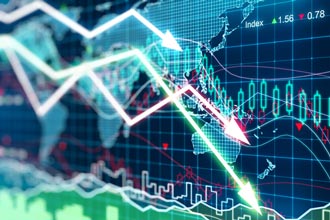"Black Thursday" 2020 will live in infamy as one of the worst days ever for the stock market, but the worst could be yet to come.
Today, we'll give you three steps to protect your money before it gets worse...
The Dow plunged 10% in one trading day on Thursday, making it the fourth worst day behind the 1929 stock market crash and "Black Monday" in 1987.
| Date | Close | Net Loss | % Loss |
| Oct. 19, 1987 | 1,738.74 | -508.00 | -22.61% |
| Oct. 28, 1929 | 260.64 | -38.33 | -12.82% |
| Oct. 29, 1929 | 230.07 | -30.57 | -11.73% |
| March 12, 2020 | 21,200.62 | -2,352.60 | -9.99% |
| Nov. 6, 1929 | 232.13 | -25.55 | -9.92% |
But as you can see with the 1929 stock market crash, the bleeding didn't stop after one historically bad day. That's the nature of a market crash. Once the selling begins, everyone wants out. And the more people who sell, the more it pushes prices down, forcing even more people to cut their losses.
After the market's historically bad day on Thursday, stocks have slightly rebounded on Friday. But that could be just another dead cat bounce.
After stocks plunged 1,000 points on Monday (the 12th worst day for the Dow ever), stocks bounced up 900 points on Tuesday. That turned out to be false hope.
Market watchers blamed U.S. President Donald Trump's Oval Office speech on Tuesday night for the plunge on Wednesday. The solemn speech was a sign of the severity of the coronavirus crisis, and the president mistakenly said all trade with Europe would be cut off, further spooking investors.
No amount of corrections or clarifications on Wednesday could stem the tide, not even a $1.5 trillion intervention from the U.S. Federal Reserve.

The crisis is only deepening now. Major events are being cancelled in a rush, from the NCAA basketball tournament, to the NBA and NHL seasons, to even the Boston Marathon. American companies are instituting work-from-home policies while local governments try to figure out how to manage the strain on services.
Businesses are planning for at least two weeks of disruptions, with the possibility for more. We haven't seen the worst of it yet.
President Trump is scheduled to address the nation again today at 3 p.m., just an hour before trading closes for the weekend. That's likely strategic. He's expected to declare a national emergency, and there's little he can say right now to assure investors. Any negative updates or mistakes like Tuesday could sink the markets again.
We could be looking at another "Black Monday" next week.
Before it gets to that, there's still time to protect yourself.
Here are three steps you can take right now to protect yourself...
How to Protect Your Money If Stocks Keep Dropping
[mmpazkzone name="in-story" network="9794" site="307044" id="137008" type="4"]
First, know that now isn't the time to sell. It might be your first instinct when stocks plunge. You think you can stem the bleeding by getting out. The problem is you might get out at the bottom and be forced to buy back in at a higher price. That can multiply your losses.
If you're retiring soon, just retired, or need to cash out soon, it's best to consult a fiduciary financial advisor who can give you personalized advice.
If you don't need money immediately, then the best idea is to keep your stocks.
Second, if you're investing for the long haul, you actually want to increase your exposure to stocks right now. With stock prices dropping, this is your chance to buy in at prices you thought you missed on the way up.
You might want to add funds to your tax-deferred retirement accounts, like your 401(k), especially if you have an opportunity to get employer-matching contributions.
It's also a good time to rebalance your portfolio. If you've been maintaining an 80-20 stock to bond allocation, it's likely out of whack right now. Your bonds are worth more, and your stocks are worth less. Take an hour or so to figure out how much of your bonds to sell to maintain your allocation, then put the proceeds back into your stocks.
One of the best ways to do that is with a lowball order. This is where you submit a Good-Til-Canceled limit order at a price 10% or 20% below the stock's current trading price. Make a list of stocks you wished you owned but thought were too expensive, and submit these lowball orders. If they fill, then you've amplified your potential returns. That also gives you a silver lining if stocks fall more.
Third, an immediate solution is to add hedges like gold.
Gold is a safe-haven asset. Investors flock to it when stocks fall. Adding a hedge like gold can offer you stability in times like these.
We like the SPDR Gold Trust ETF (NYSEArca: GLD) as an easy way to own gold without dealing with the hassle of securing gold coins or bars. GLD is up 9% on the year, while stocks are flirting with bear market territory. If the uncertainty continues, expect gold to continue performing well.
But there are even more specific things you can do.
We've laid out everything you need to do in our complimentary guide to the coronavirus. We'll show you the stocks to sell, the hedges to own, the trades to make, and even the next stocks to buy once we hit the bottom.


